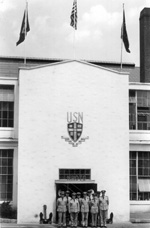
Tufts
College:
A Wartime Campus,
1943-1946

 During
World War II Tufts College was transformed by two Navy programs, the V-12
and NROTC. Student life changed dramatically as almost 1,600 Navy students
studied college courses while simultaneously following the disciplined
and strenuous military training of the Navy programs. At the same time
life carried on as usual: students continued to study, go to football
games, and complain about the cafeteria food.
During
World War II Tufts College was transformed by two Navy programs, the V-12
and NROTC. Student life changed dramatically as almost 1,600 Navy students
studied college courses while simultaneously following the disciplined
and strenuous military training of the Navy programs. At the same time
life carried on as usual: students continued to study, go to football
games, and complain about the cafeteria food.
Under the direction of President Leonard Carmichael, Tufts College wholeheartedly focused its energies on the war effort. The Navy presence on campus reflected this new purpose more than anything else. The regimen and traditions of the U.S. Navy were integrated into many aspects of campus life as the campus itself witnessed numerous physical changes and rearrangements.
The civilian male students, female Jackson students and
returning war veterans were all affected. In 1942, Tufts  implemented
a year-round schedule, no spring or summer breaks and three days off for
Christmas. "War courses," such as Camouflaging and Motor Transport, were
offered to civilian students to help prepare the nation in case of invasion.
Victory gardens, blood drives, first aid training, and book drives all
became familiar activities and topics of conversation.
implemented
a year-round schedule, no spring or summer breaks and three days off for
Christmas. "War courses," such as Camouflaging and Motor Transport, were
offered to civilian students to help prepare the nation in case of invasion.
Victory gardens, blood drives, first aid training, and book drives all
became familiar activities and topics of conversation.
Throughout the war, Tufts tried to maintain the atmosphere of a normal college campus by continuing dances and organized sports in addition to other social events. Tufts role in the war, as it trained military personnel, participated in government research, and encouraged civilian support of the war, not only strengthened the academic and athletic programs at Tufts, but transformed it into a national institution. Overall, attending Tufts during the war years proved to be an entirely unique experience.